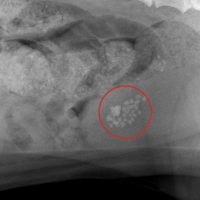What is yeast dermatitis?
Yeast dermatitis or Malassezia dermatitis is caused by the fungus Malassezia pachydermatis. It is an extremely common cause of skin disease in dogs. This yeast is normally found on the skin, but its abnormal overgrowth can cause dermatitis, or inflammation of the skin.
What are the clinical signs of a yeast skin infection?
The most common clinical signs of yeast dermatitis are:
- itching and redness
- musty odor
- scales and crusty, flaky skin
- thickened skin
- hyperpigmentation (darkly pigmented skin)
- chronic or recurrent otitis externa or ear infections
How does a dog get a yeast skin infection?
The skin is host to innumerable bacteria and fungi. Under normal circumstances, these organisms do not cause a problem and are kept under control by the immune system. If conditions on the skin change or if the immune system is suppressed, these bacteria and fungi can cause infection. These types of infections are termed opportunistic infections. If the number of yeast organisms on the skin increases, a yeast skin infection results.
A common cause of a yeast skin infection is an increase in the amount of oils produced on the skin. This is most frequently associated with allergic skin disease. Another common cause of excess skin oils is seborrhea oleosa.
Some dogs have an immune deficiency making them ineffective at fighting yeast infections resulting in chronic infection. Dogs that receive immunosuppressive drugs such as corticosteroids (steroids) may also be unable to effectively prevent yeast infections, so they may develop a chronic yeast infection.
Yeast dermatitis is not contagious; your dog did not get this infection from another dog. Opportunistic yeast infections often recur unless the underlying allergy or skin condition is controlled.
There are certain breeds thought to be genetically predisposed to developing yeast infections. These breeds include West Highland White Terrier, Basset Hound, Cocker Spaniel, Silky Terrier, Australian Terrier, Maltese, Chihuahua, Poodle, Shetland Sheepdog, Lhasa Apso, and Dachshund.
Some dogs develop a hypersensitivity to yeast, becoming allergic to an organism they are exposed to all the time. Those dogs have an intense, inflammatory reaction, but only a few yeast are present on their skin. They will often have frequent recurrences of yeast dermatitis, some starting shortly after treatment is discontinued.
How is yeast dermatitis diagnosed?
There are several techniques used to collect samples for diagnosing yeast dermatitis:

- Skin scraping – scraping the skin with a dull blade to collect yeast organisms
- Impression smear – pressing a microscope slide on the skin to collect yeast organisms.
- Cotton swab sample – rubbing a moistened swab on the skin to collect yeast organisms.
- Acetate tape preparations – applying a piece of clear tape to the skin to collect yeast organisms.
- Skin biopsy – obtaining a small piece of skin with a biopsy punch. This is the most invasive diagnostic test, but it provides the most complete diagnostic information. This is sent to a veterinary pathologist for examination.
Most samples can be examined in-clinic under a microscope by a veterinarian or veterinary technician.
If yeast hypersensitivity is suspected, your veterinarian or dermatologist may recommend running blood and/or skin tests to confirm this diagnosis.
How is yeast dermatitis treated?
Treatment for yeast dermatitis may be topical, oral, or a combination of both, and is based on the severity of your dog’s condition.
Topical treatment. Treatment with medicated shampoos is a vital part of treating yeast dermatitis. Many dogs with greasy or oily skin will require an initial ‘degreasing’ cleansing with a shampoo containing selenium sulfide or benzoyl peroxide. After the initial bathing is complete, bathing with an anti-fungal shampoo containing chlorhexidine, miconazole, or ketoconazole is performed. It is important that the anti-fungal shampoo remains in contact with the skin for at least ten minutes. To be effective, this topical treatment is required every three to five days for two to twelve weeks. If the infection is in the ears or in only one or two spots on the skin, a topical ointment may be prescribed for daily use.
Oral treatment. In more severe, chronic, or persistent cases of yeast dermatitis, the use of oral or systemic antifungal medications is often required. Many dogs with yeast dermatitis will also have a bacterial skin infection (pyoderma) and will require antibiotics to treat the bacterial infection for typically four to twelve weeks. Oral antifungal medications include ketoconazole, terbinafine, itraconazole, and fluconazole.
Although these medications are highly effective, they must be given for prolonged periods of time (often several months). Because these drugs have potential side effects, particularly involving the liver, close monitoring with routine blood tests is necessary. If the dog has a relapse of the fungal infection after an initial successful treatment, a higher dose of the antifungal medication will usually be required. Most dogs with advanced or chronic yeast dermatitis are treated with a combination of oral and topical treatment.
Affected dogs may also need medications such as corticosteroids (prednisone), cyclosporine (Atopica), Apoquel, or Cytopoint to relieve inflammation and itch while the antifungal therapy is taking effect.
Dogs with yeast hypersensitivity will often have better control of their disease by using immunotherapy. This is used to try to reprogram the dog’s immune system so it does not overreact to this naturally occurring yeast. The treatment may be given by injection under the skin or by oral administration.
What is the prognosis for yeast dermatitis?
The prognosis for yeast dermatitis is generally good. While the condition usually requires long-term treatment, the majority of cases respond favorably and the itching is reduced within a week of beginning therapy.
In cases with underlying allergies or immunocompromised, the prognosis is based on the ability to control those conditions. It is not uncommon for dogs with severe skin allergies to have recurrent secondary yeast or bacterial skin infections, sometimes two or three times a year. Your veterinarian will discuss a diagnostic and treatment plan for your dog to help you manage this condition.
© Copyright 2022 LifeLearn Inc. Used and/or modified with permission under license.






